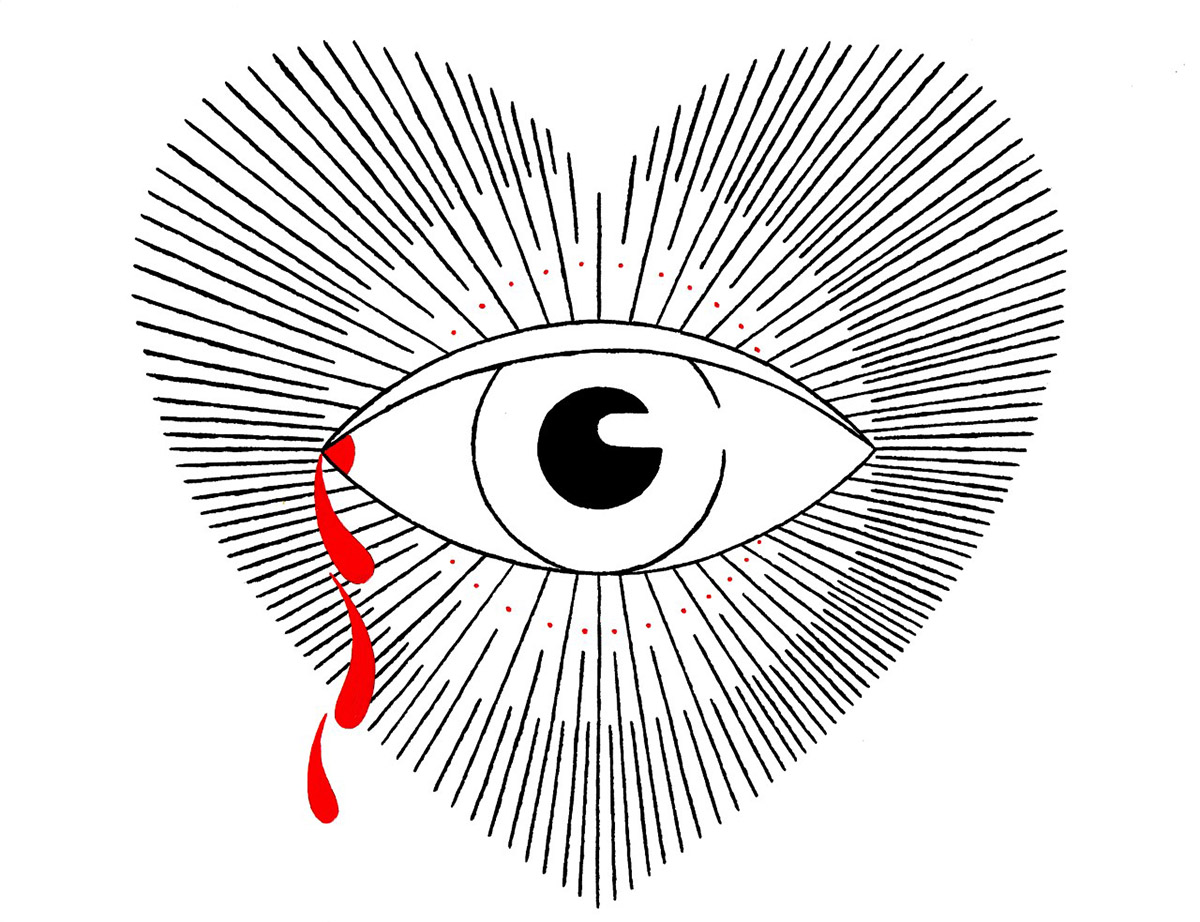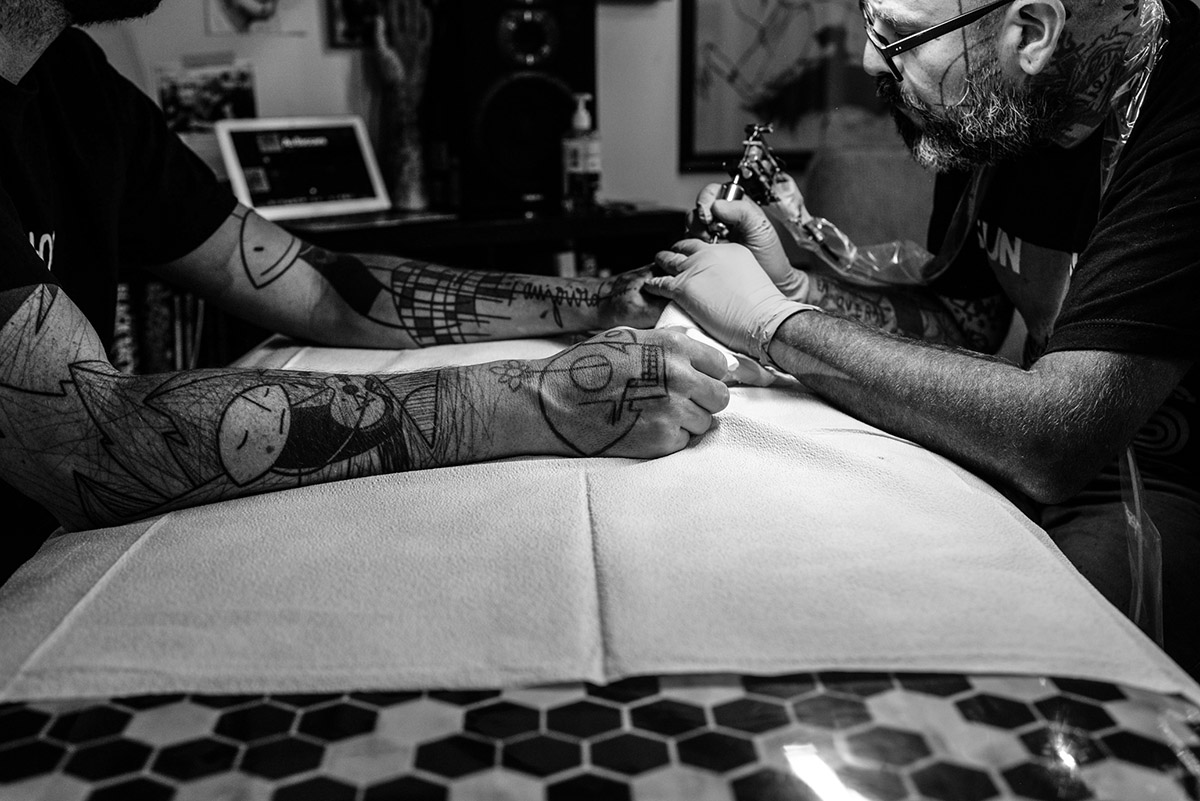Who hasn’t heard of Yann Black ? A true pioneer of the graphic style in France, he is an inspiration for numerous artists of his generation and helped give birth to a new, innovative and minimalist style. At a time when traditional, Japanese or tribal styles were omnipresent, Yann Black imposed his personal style and vision of tattooing. At first glance his work seems either particularly dark or on the contrary somewhat childish. This specialist of lines and blackouts, outlined crosses and animals threw away the rule book and freed tattooing from its proverbial straitjacket.Here he talks about his travels between Bourges, Paris and Brussels before expatriating to Montreal, and also evokes his early faux-pas, the lukewarm welcome he first received and some fateful encounters.Don’t miss his show in Paris this Fall for an exceptional opportunity to see his work exhibited !

Hi Yann, tell us a bit about your first tattoo.
I was born in Bourges, which is a small town in the middle of France. I was studying at an animation school in Roubaix and I’d just come back from the Summer break. My best friend and I went to get inked, I got there and showed the guy my drawing full of little black squares and he did it. I was instantly fascinated, but I was also panicking for him, what a crazy job ! I don’t know why I wanted that first tattoo because no one from my hometown had any. Until then, the only people I’d seen with tattoos were the punks who traveled down to the Printemps de Bourges festival every year.


What about your latest one ?
It was done by Val, my kids’ mom. Emile, my youngest, did a drawing of crying eyes with the words ‘sorrow’ and ‘sadness’ that I’d requested for a t-shirt design. Val inked the eyes onto each side of my shoulders, but we haven’t added the words yet. I get inked a lot and often. As a tattooist, I think you tend to forget how painful it is and when a client is in pain and can’t stand it anymore, we just want to get the piece finished. But getting inked does hurt and as one of Kostek’s clients once said, ‘it’s a lonely road’.


Talking of how you got started, how did you learn to draw ?
I don’t really know how to draw, meaning that if you ask me to draw a rose, I’ll find a way of doing it in my style. I studied at a school for animation design in Roubaix, but I was young, between 15 and 18 years old, that’s where I learned to really draw. I spent my childhood at exhibitions looking at paintings. I’ve always drawn a lot but always used my own style. I took the academic route for a while but I didn’t have a real interest in it. I have an eye for composition and that’s why people come to me.


How did you start tattooing ?
I started out in Bourges. I came back to show my drawing to a guy who’d inked me. He managed to get some equipment for me in Orléans and I got a little tribal piece that I’ve had covered since. At the time, in France, tattooing was a marginal activity. I inked my dad and my best friend, then my friends in Roubaix but I didn’t earn any money for years. When I got to Brussels, that changed and I learned how to solder needles and got invited to work in Paris at Tribal Act. I got there with a folder full of weird stuff, kids’ drawings, black squares and abstract forms. I stayed for a few months and earned money for the first time in my life which was pretty amazing. I was the only tattooist there, everything else was piercing. I ended up staying 8 years in Paris.


How did you meet the team from La Boucherie Moderne ?
I met Jeff, we started tattooing the same year, and he was working in a biker bar at the time. Then we met again a few years later at a festival at Dour in Belgium with Kostek who was a screen printer and we became friends. And when they opened La Boucherie Moderne, they asked me to come and tattoo there as a guest.


What brought you to Montreal ?
Actually I met Olivier Julliand during one of my rare outings to a convention when I was living in Rennes. He had a shop in Toulouse and invited me there regularly. He’d been several times to the Montreal convention and had fallen in love with Quebec so he wanted to move there with his wife and kids and suggested that I come too. I did all the paperwork, which took me 2 years, then I went to join Olivier who’d opened his shop there. No one knew my work so it was like starting all over again, then I started inking the French expat community there.


You pushed back the limits of traditional tattooing and became a pioneer of the graphic style in France. Were you conscious of that when you started doing tattoos ?
Honestly, no, because what I was doing through ink was what I was already doing with my drawing at the time. I didn’t set out to do something incredibly different, it just happened. It was new. There’s a whole clientele who likes the idea of getting inked but graphically speaking, nothing really attracted them. When they saw the kids’ drawings, nothing like that existed at the time, people didn’t know that it was possible to do something so different.


Did you get a lukewarm reception at first ?
When Lionel sent photos of my tattoos to an American magazine, I got a handwritten letter back from a guy in Texas telling me how ugly they were, that they were a disgrace to tattooing. Even after 30 years of tattooing, I still have doubts. It’s tough marking someone for life, it’s a big responsibility.


You design a lot of skulls, crosses, fire, always very black. How would you define your style ?
I’ve always drawn crosses. When I saw the film ‘Jesus of Nazareth’ I loved it. I found the crucifixion scene fascinating. I love religious imagery and death terrifies me. When I was a kid, I had really dark dreams about death. I don’t know where that comes from, but I think about death all the time, I don’t even need to get inked with a Memento Mori. I don’t get inspiration from other artists, I only really express my own emotions.


You also do more naive, simpler looking motifs, sometimes animals. Have you adapted your tattooing style to your drawing, or is it the contrary ?
I drew a lot around the time when I was making comics and fanzines. My drawing style has changed over the years, and actually I do that in harmony with my body, so there are obviously constraints sometimes. Actually, what I do now, I already did in those days. It’s something I already had in me and that has matured and been developed, but it’s always been there.


You never do flashes and only work to order. Is it because you want to tell a unique story each time ?
Yes, that’s it. Clients arrive in the morning and I have no idea what I’m going to tattoo. I love that because it’s about the encounter and it lasts all day long. We take some time to discuss it, then I draw directly onto their skin. I only do freehand because if I draw on paper, then put that onto volume, it’s not going to work.


You’re a vegan and an activist, how do your convictions feed your creativity ? Do you use your art to convey a message ?
One of the cool things about a tattoo session is that intimate moment where you get to really talk with people. When they make an appointment with me, it’s clear from the start and in my signature that they can’t bring any animal products into the studio. @yannblacktattoo



































